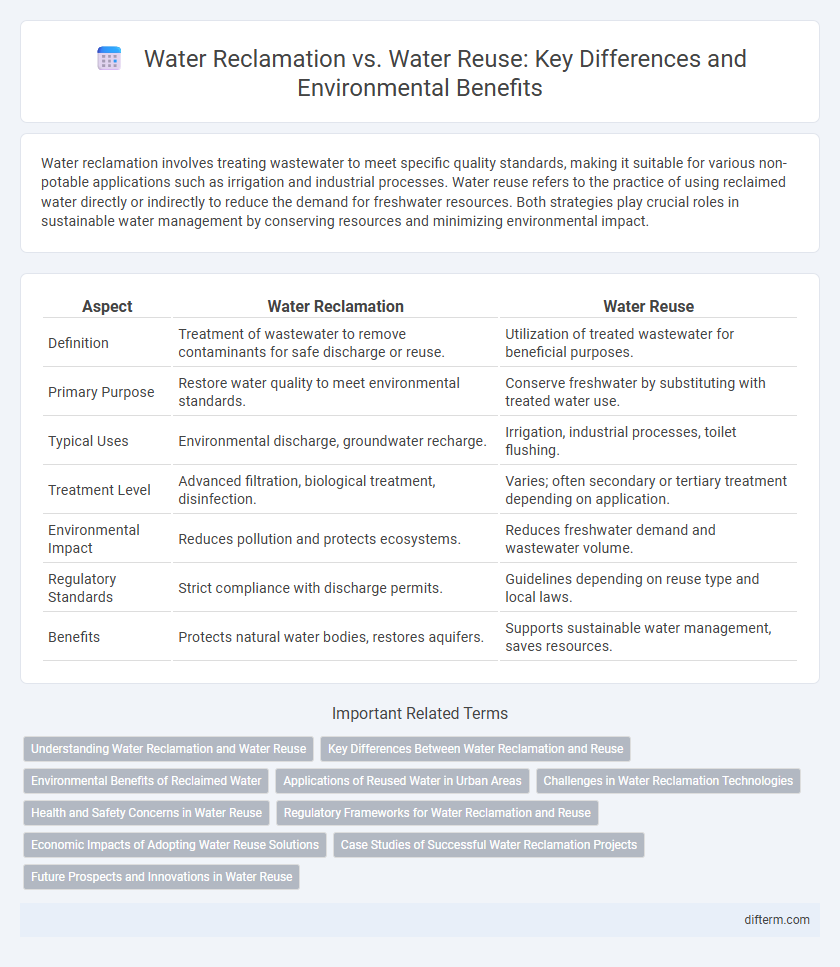Water reclamation involves treating wastewater to meet specific quality standards, making it suitable for various non-potable applications such as irrigation and industrial processes. Water reuse refers to the practice of using reclaimed water directly or indirectly to reduce the demand for freshwater resources. Both strategies play crucial roles in sustainable water management by conserving resources and minimizing environmental impact.
Table of Comparison
| Aspect | Water Reclamation | Water Reuse |
|---|---|---|
| Definition | Treatment of wastewater to remove contaminants for safe discharge or reuse. | Utilization of treated wastewater for beneficial purposes. |
| Primary Purpose | Restore water quality to meet environmental standards. | Conserve freshwater by substituting with treated water use. |
| Typical Uses | Environmental discharge, groundwater recharge. | Irrigation, industrial processes, toilet flushing. |
| Treatment Level | Advanced filtration, biological treatment, disinfection. | Varies; often secondary or tertiary treatment depending on application. |
| Environmental Impact | Reduces pollution and protects ecosystems. | Reduces freshwater demand and wastewater volume. |
| Regulatory Standards | Strict compliance with discharge permits. | Guidelines depending on reuse type and local laws. |
| Benefits | Protects natural water bodies, restores aquifers. | Supports sustainable water management, saves resources. |
Understanding Water Reclamation and Water Reuse
Water reclamation involves treating wastewater to meet specific quality standards for non-potable or potable applications, enhancing sustainable water management. Water reuse refers to the practical application of reclaimed water in agricultural irrigation, industrial processes, or groundwater recharge, reducing freshwater demand. Advanced treatment technologies like membrane filtration and UV disinfection ensure reclaimed water safety for diverse reuse purposes.
Key Differences Between Water Reclamation and Reuse
Water reclamation involves treating wastewater to a quality suitable for environmental discharge or non-potable applications, while water reuse refers to the direct use of reclaimed water for specific purposes such as irrigation, industrial processes, or groundwater recharge. The key differences lie in treatment levels, regulatory standards, and intended end-uses; reclamation focuses on processing and purification, whereas reuse emphasizes application efficiency and resource conservation. Understanding these distinctions is critical for optimizing water management strategies and sustainable resource utilization in environmental planning.
Environmental Benefits of Reclaimed Water
Reclaimed water significantly reduces freshwater extraction by treating and repurposing wastewater for agricultural irrigation, industrial processes, and groundwater recharge, enhancing sustainability. It decreases the discharge of pollutants into natural water bodies, improving aquatic ecosystems' health and biodiversity. Utilizing reclaimed water also helps mitigate water scarcity and supports climate resilience by providing a reliable alternative water source.
Applications of Reused Water in Urban Areas
Reused water in urban areas primarily supports irrigation of public parks, green spaces, and golf courses, reducing demand on potable water supplies. Industrial applications such as cooling towers and boiler feed water benefit from reclaimed water, enhancing sustainability and lowering freshwater extraction. Additionally, reused water aids in street cleaning and landscape irrigation, contributing to urban water conservation efforts and promoting efficient water resource management.
Challenges in Water Reclamation Technologies
Water reclamation technologies face significant challenges including high energy consumption, complex treatment processes, and the removal of emerging contaminants such as pharmaceuticals and microplastics. Advanced membrane filtration and biological treatment methods require substantial infrastructure investment and can generate concentrated waste streams that complicate disposal. Ensuring water quality standards for various reuse applications while managing operational costs remains a critical obstacle in the widespread adoption of water reclamation systems.
Health and Safety Concerns in Water Reuse
Water reuse presents health and safety concerns due to potential contamination by pathogens, chemicals, and emerging pollutants that may not be fully removed during treatment. Effective water reclamation technologies integrate advanced filtration, disinfection, and continuous monitoring to mitigate risks and ensure compliance with public health standards. Strict regulatory frameworks and real-time quality assessments are essential to protect communities and ecosystems from waterborne diseases and toxic exposure.
Regulatory Frameworks for Water Reclamation and Reuse
Regulatory frameworks for water reclamation and reuse vary globally, with agencies such as the U.S. Environmental Protection Agency (EPA) establishing stringent guidelines to ensure public health and environmental protection. These regulations mandate pathogen reduction, water quality monitoring, and specific treatment processes to make reclaimed water suitable for non-potable or potable uses. Compliance with standards like the EPA's Clean Water Act and guidelines from the World Health Organization (WHO) facilitates safe water reuse, contributing to sustainable water management and resource conservation.
Economic Impacts of Adopting Water Reuse Solutions
Water reuse solutions significantly reduce municipal water procurement and treatment costs by recycling effluent for non-potable applications, decreasing reliance on costly freshwater sources. Adoption leads to increased economic resilience by stabilizing water supply for industries and agriculture amid scarcity, fostering sustainable business operations and job retention. Investments in water reuse infrastructure generate long-term financial benefits through lowered utility expenses and incentivize innovation in water-efficient technologies.
Case Studies of Successful Water Reclamation Projects
The Orange County Water District in California has demonstrated a leading example of water reclamation by converting wastewater into high-quality potable water, significantly reducing groundwater depletion. Singapore's NEWater project showcases advanced membrane technology and ultraviolet disinfection to produce ultra-clean reclaimed water, contributing to 40% of the country's water demand. These case studies highlight how innovative water reclamation techniques can ensure sustainable water reuse, mitigate scarcity, and support urban resilience.
Future Prospects and Innovations in Water Reuse
Water reuse technologies are rapidly advancing with innovations such as membrane bioreactors, advanced oxidation processes, and smart monitoring systems enhancing treatment efficiency and safety. Future prospects include integrating artificial intelligence for real-time water quality management and deploying decentralized systems to support sustainable urban water cycles. These innovations promise to expand water reclamation's role in addressing global water scarcity and enabling circular water economies.
water reclamation vs water reuse Infographic

 difterm.com
difterm.com